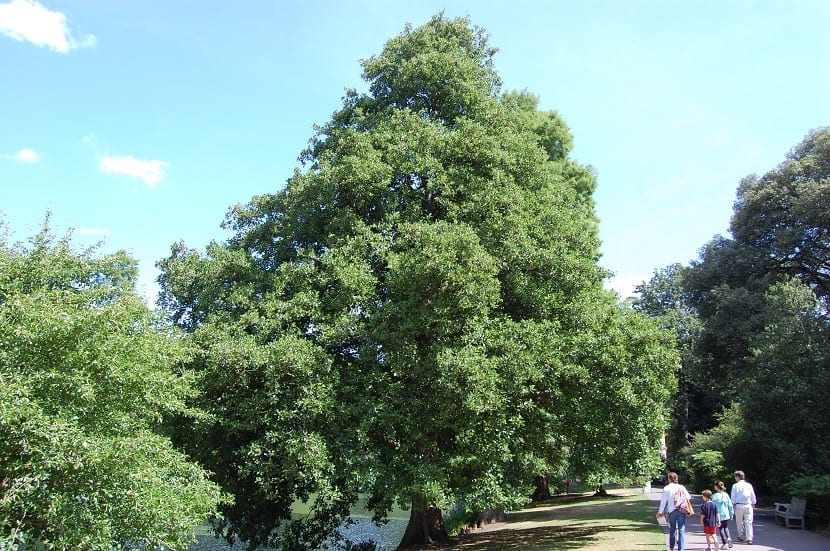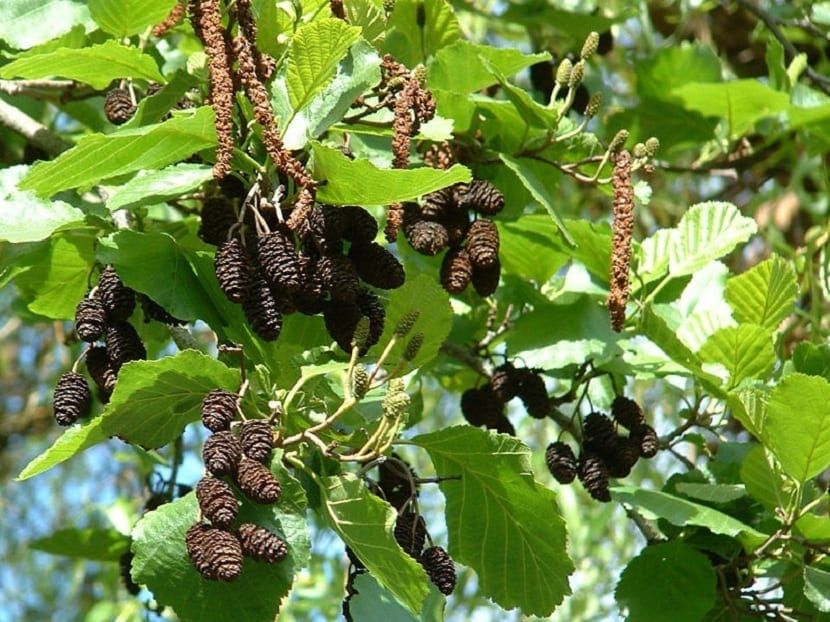
Today we are going to talk about a fairly long-lived tree that comes from the deciduous forests of northern Europe and Asia. It is about the alder or alno. The scientific name is glutinous alnus and it belongs to the Betulaceae family where there are more than 30 tree and shrub species. The area of distribution is mainly in the colder areas of the northern hemisphere.
This tree is capable of living 120 years and measuring 30 meters in height. Do you want to know all its secrets, care and characteristics that make it special? Read on to find out everything.
Description
This long-lived tree can live for more than 120 years. Despite measuring up to 30 meters in height, they are usually straight and fairly clean trees. Its crown is pyramidal in shape and the branches are thin. Although it can grow into a fairly large tree, it is usually cut down for firewood.
It is a fairly easy tree to recognize at any time of the year. The clusters it possesses have some quite characteristic dark and ovoid strobili. When it is found in shallower soils, it can be seen that it does not have a true central root, but that it consists of some secondary roots that try to lengthen and cover the maximum possible terrain and thus capture the necessary nutrients for its development.
As for its leaves, they are simple and alternate. We can find it with dimensions ranging from 6 cm long and 5 cm wide. Although it is a deciduous tree, its leaves can remain on the tree throughout the winter if there is not too much wind or rain to make them fall completely. In the spring and summer season, it has leaves with a green color on both sides, although it is lighter on the underside.
The characteristic color of the glutinous alnus it is reddish brown. Flowers in the month of August and September and matures spreading the seeds during the months of March and April. The bark is smooth with a greenish brown color and, as it grows and ages, it becomes with a cracked texture and a brown or dark gray color.
Alder requirements
Climate

El alder it is an arboreal species quite resistant to cold. Thanks to this ability to adapt to different environments, it has been able to survive perfectly up to temperatures of -17 degrees. When temperatures start to rise in spring, but there are still some night frosts, this is when it becomes more sensitive. This is because it is getting used to and "relaxing" to more pleasant temperatures after the cold of winter and the leaves are beginning to develop. It is when frost is most affected.
As well can tolerate fairly humid or dry climates, as long as the soil has enough moisture to be able to stay fresh and nourished at all times. It is resistant to drought to such an extent. It can survive a range of annual rainfall ranging from 400mm to 2000mm. If it rains more it could be an excess of humidity and can cause waterlogging.
The optimum temperature range for the glutinous alnus can live in good conditions is between 8 and 14 degrees. These temperatures are more frequent in the northernmost areas of Europe.
Land

As for the ground, It is not a species that is very demanding of the type of soil where it is found. It is capable of growing perfectly in both granite and limestone soils. The mineralogical characteristics of these do not matter too much. The determining material in this type of soils is the amount of organic matter that there is. They need a contribution of organic matter to be able to nourish themselves much better and reach the heights they can reach.
The most frequent places where we find alder are those soils that are quite humid and close to the banks of rivers and lakes. We can also find ourselves at the bottom of the valleys where more moisture and organic matter accumulates as a result of the dragging of the slope. In swampy areas and some bogs they can also be seen thanks to their high moisture content. It is an opportunistic species that can develop and grow in some drainage pits, taking advantage of the curves of the terrain to thrive in areas where humidity and organic matter accumulate.
It is a fairly good tree species for the soils where they are found since contributes to the improvement of soil capacities to improve quality and nitrogen content. This is due to a symbiotic relationship between the bacteria found in their roots and because of their high nitrogen content in their decomposed leaves. A sufficiently nitrogenous soil will have more capacity to feed the plants, trees and shrubs that reside in it.
Altitude, tolerance and symbiosis

We can find the glutinous alnus at altitudes of 1300 meters above sea level. At this point there are the most ideal conditions for it to develop well. It has a fair tolerance for light. It is able to survive in medium sunlight and shade on some occasions.
As for the aforementioned symbiosis, the activity of the bacteria in their roots is essential so that, in the soil where they are found, they can fix more nitrogen and increase the quality of the soil where they are found.
Caring for the glutinous alnus

To take care of this tree in our garden, the first thing is to live at a height close to the one we have named above so that it can develop in good conditions. They need exposure to the sun or semi-shade and warm temperatures. As for the soil, or more ideally, it is humid so that it can carry out its activities
It is not a very demanding plant with the soil in which they are found and you can improve its quality by having a higher rate of nitrogen fixation. The risks must be abundant so that the soil always maintains its humidity but without flooding it. It does not need neither pruning nor special fertilizer.
You can multiply them through woody cuttings which are done when there is no longer frost well into spring.
I hope that with this information you will learn more about this long-lived tree.
